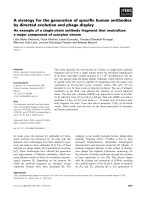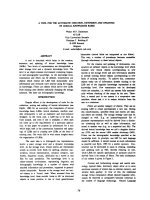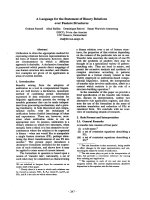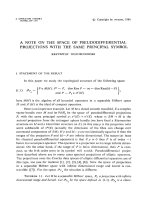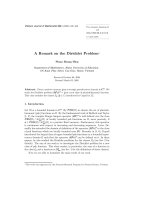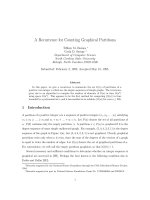Báo cáo toán học: "A formula for the bivariate map asymptotics constants in terms of the univariate map asymptotics constants" pps
Bạn đang xem bản rút gọn của tài liệu. Xem và tải ngay bản đầy đủ của tài liệu tại đây (213.97 KB, 14 trang )
A formula for the bivariate map asymptotics constants
in terms of the univariate map asymptotics constants
Zhicheng Gao
∗
School of Mathematics and Statistics
Carleton University
Ottawa, Canada K1S 5B6
Submitted: Oct 18, 2010; Accepted: Nov 9, 2010; Published: Nov 19, 2010
Mathematics Subject Classification: 05C10, 05C30
Abstract
The parameters t
g
, p
g
, t
g
(r) and p
g
(r) appear in the asymptotics for a varie ty of
maps on surfaces and embeddable graphs. In this paper we express t
g
(r) in terms
of t
g
and p
g
(r) in terms of p
g
.
1 Introduction
The concepts in this paragraph will be made precise in the following paragraphs. The
parameters t
g
and p
g
arise in the univariate asymptotic enumeration of a variety of maps
on surfaces and the parameters t
g
(r) and p
g
(r) arise in the corresponding bivariate asymp-
totics for maps as well as embeddable graphs. The original recursions for these parameters
make it extremely difficult to compute them for higher genus surfaces. In contrast, the
other parameters in the asymptotics are usually easily determined. Recently a simple
recursion has been obtained for t
g
and another conjectured for p
g
. In this pape r, we
obtain simple expressions for the bivariate parameters t
g
(r) and p
g
(r) in terms of the
corresponding univariate parameters.
A map is a connected graph G embedded in a surface S (a closed 2-manifold) such
that all components of S −G are simply connected regions, which are called faces. Loops
and multiple edges are allowed in G. A map is rooted if an edge is distinguished together
with a direction on the edge and a side of the edge. The exact enumeration of various
types of maps on the sphere (or, equivalently, the plane) was carried out by Tutte and
his students (see [28] for a survey) in the 1960s via his device of ro oting. Beginning in
the 1980s, Tutte’s approach was used for the asymptotic enumeration of maps on general
surfaces [3, 4, 9, 11, 16, 17, 18, 19]. A matrix integral approach was initiated by
t
∗
Research supported by NSERC
the electronic journal of combinatorics 17 (2010), #R155 1
Hooft (see [25] for various connections with quantum gravity, representation theory, and
algebraic geometry). Let T
g
(n) (P
g
(n)) be the number of rooted n-edge maps on the
orientable surface of genus g (non-orientable surface with 2g cross-caps). In 1986 Bender
and Canfield showed that, for each fixed g and as n → ∞,
T
g
(n) ∼ t
g
n
5(g−1)/2
12
n
, P
g
(n) ∼ p
g
n
5(g−1)/2
12
n
, (1)
where t
g
and p
g
are positive constants which can be computed by complicated recursions.
In 1988 Bender and Wormald [11] derived similar asymptotic formulas for 2-connected
maps in which the constants t
g
and p
g
also appear.
In 1993, the author [18] showed that many natural families of maps satisfy asymptotic
formulas similar to (1) in which the same constants t
g
and p
g
appear in the coefficients.
So in some sense t
g
and p
g
are universal constants. There is a nice connection between t
g
and Painlev´e I ODE, and this connection seems to be well-known in the quantum physics
community. However, there are doubts as to whether the proofs of the relevant results
in the physics literature are mathematically rigorous. See, e.g., [25, Section 3.6] and [14,
p. 29] for some related information. It is also worth mentioning that conjecture (74) stated
in [14, p. 29] follows immediately from [19, T hm. 1.4].
Recently, using representation theory and KP- hierarchy, Goulden and Jackson [22]
derived a remarkably simple recursion for the numbers of rooted triangulations of ori-
entable surfaces. Let C
n,g
be the number of rooted 2n-face triangulations (or, by duality,
2n-vertex cubic maps) of an orientable surface of genus g. Define H
n,g
= (3n + 2)C
n,g
for
n 1, g 0, and
H
−1,0
= 1/2, H
0,0
= 2 and H
−1,g
= H
0,g
= 0 for g = 0.
Goulden and Jackson [
22] showed that, for (n, g) = (−1, 0),
H
n,g
=
4(3n + 2)
n + 1
n(3n −2)H
n−2,g−1
+
n−1
i=−1
g
h=0
H
i,h
H
n−2−i,g−h
.
(2)
Bender et al. [7] used this recursion to derive a simple recursion for t
g
which leads to an
asymptotic formula for t
g
. This asymptotic formula for t
g
was used in [
20] to settle a
conjecture of
t Hooft about analyticity of free energy. Let
f
g
= 24
−3/2
6
g/2
Γ
5g − 1
2
t
g
.
It was shown in [7] that
f
g
=
√
6
96
(5g − 4)(5g − 6)f
g−1
+ 6
√
6
g−1
h=1
f
h
f
g−h
, f
0
= −
√
6
72
,
and hence the generating function f(z) =
g1
f
g
z
g
satisfies the following second order
nonlinear ODE: (note there are two typos in the ODE given in [7])
f(z) = 6
√
6(f(z))
2
+
√
6
96
z
25z
2
f
(z) + 25zf
(z) −f(z) +
√
6
72
.
the electronic journal of combinatorics 17 (2010), #R155 2
Garoufalidis et al. [20] noticed that the above ODE is Painlev´e I in disguise. More
precisely, they noticed that
a
g
= −
72
√
6
2
√
6
g
f
g
= −2
g−2
Γ
5g − 1
2
t
g
satisfies the following recursion
a
g
=
(5g − 4)(5g − 6)
48
a
g−1
−
1
2
g−1
h=1
a
h
a
g−h
, a
0
= 1, (3)
and the formal series w(z) =
g0
a
g
z
−(5g−1)/2
satisfies the following Painlev´e I:
w
(z) = 6w
2
(z) −6z.
This recursion was studied by Joshi and Kitaev [24] in the context of Painlev´e I, and they
derived the following full asymptotic expansion:
a
g
∼
S
π
A
−2g+1/2
Γ(2g − 1/2)
1 +
l1
µ
l
A
l
l
k=1
(2g − k − 1/2)
,
where
A =
8
√
3
5
, S = −
1
2
√
π
3
1/4
,
and µ
l
can be computed recursively using
µ
l
=
5
16
√
3l
192
25
l−1
k=0
µ
k
a
(l−k+1)/2
− (l −
9
10
)(l −
1
10
)µ
l−1
, µ
0
= 1.
In the above (and below), it is understood that a
j
= 0 when j is not an integer.
Based on evidence from quantum physics, Garoufalidis and Mari˜no [21] conjectured
that
p
g
=
1
2
g−2
Γ
5g−3
2
v
2g−1
, (4)
where v
g
satisfies
v
g
=
1
2
√
3
−3a
g/2
+
5g − 6
2
v
g−1
+
g−1
k=1
v
k
v
g−k
,
and a
j
is defined by (3). In [21], a nice asymptotic formula was also derived for v
g
using
the above recursion for v
g
and the asymptotic expression for a
g
.
the electronic journal of combinatorics 17 (2010), #R155 3
In [5, 12], interesting connections were shown between t
g
and the gth moment of some
random variables defined on trees.
In 1993, Bender, Canfield, and Richmond [4] derived a bivariate version of formula (1).
Let T
g
(i, j) (P
g
(i, j)) be the number of rooted maps, with i faces and j vertices, on the
orientable surface of genus g (non-orientable surface with 2g cross-caps). They showed
T
g
(i, j) ∼ t
g
(r)(ij)
5g/4−3/2
u
−i
0
v
−j
0
, P
g
(i, j) ∼ p
g
(r)(ij)
5g/4−3/2
u
−i
0
v
−j
0
, (5)
where
u
0
=
r
3
(2 + r)
4(1 + r + r
2
)
2
, v
0
=
1 + 2r
4(1 + r + r
2
)
2
, (6)
and r > 0 is determined by j/i using the equation
j
i
=
1 + 2r
r
2
(2 + r)
.
For each r > 0, t
g
(r) and p
g
(r) are positive constants which can be computed by compli-
cated recursions (which are given in sections 2 and 3 below).
Our main result in this paper is the following.
Theorem 1 Define
c(r) =
r
3
(1 + 2r)(2 + r)
32
√
π
(4 + 7r + 4r
2
)
−1/2
(1 + r + r
2
)
−7/2
,
d(r) = 32
√
3r
−7/2
(1 + r + r
2
)
4
(1 + r)
3/2
(2 + r)
−5/4
(1 + 2r)
−5/4
.
Then
t
g
(r) = c(r)[d(r)]
g
t
g
,
(7)
p
g
(r) = c(r)[d(r)]
g
p
g
. (8)
We note that the above formulas easily lead to asymptotic formulas for t
g
(r) and p
g
(r)
(as g → ∞), using the corresponding asymptotic formulas for t
g
and p
g
.
Finally we mention that t
g
(r) and p
g
(r) also app ear in the asymptotic expressions for
the numbers of 2-connected and 3-connected maps with i faces and j vertices [6]. Recently
there have been considerable interest in enumerating graphs with a given genus (see, e.g.,
[8, 23, 26, 27]). Let G(S; n) be the number of labelled graphs (no loops or multiple edges)
with n vertices which are embeddable in a surface S. In [26], McDiarmid established the
exponential growth rate of G(S; n)/n! by showing that, for e ach fixed surface S,
lim
n→∞
(G(S; n)/n!)
1/n
= γ
for some positive constant γ which is independent of S. The algebraic growth rate of
G(S; n) was only established very recently. Bender and Gao [
6] and Chapuy et al. [13]
independently showed that
G(S; n)/n! ∼ c(S)n
(5g−7)/2
γ
n
, (n → ∞)
the electronic journal of combinatorics 17 (2010), #R155 4
where g = 1 −χ(S)/2 with χ(S) being the Euler characteristic of the surface S, and c(S)
is a positive constant depending on S. In [6], it was shown that
c(S) =
AB
g
t
g
(r
0
) : when S is the orientable surface of genus g,
AB
g
p
g
(r
0
) : when S is the non-orientable surface with 2g cross-caps,
where r
0
, A, and B are positive constants which are independent of S. Furthermore,
t
g
(r) and p
g
(r) also appear in the asymptotic expressions for the numbers of k-c onnected
(0 k 3) labelled graphs of genus g with respect to vertices and edges.
Our approach is similar to that used in [18]. Using an appropriate normalizing factor,
we can show that the complicated recursions satisfied by t
g
and t
g
(r) (similarly for p
g
and p
g
(r)) are equivalent. The main difference is that here we are comparing recursions
for t
g
(r) (p
g
(r)), which are bivariate in the sense that they involve a second parameter
r, with the univariate recursions for t
g
(p
g
), whereas in [18] all recursions are univariate.
As a result, our normalizing factor used in this paper is slightly more sophisticated and
involves the second parameter r.
2 Connection between t
g
(r) and t
g
In this section we prove Theorem 1 for orientable surfaces. Our approach will be similar
to that used in [18]. We will show that the recursions satisfied by t
g
(r) can be normalized
to match those satisfied by t
g
. We need to recall some definitions and notation from [3, 4].
Let
ˆ
M
g
(x, y, I) be the generating function for rooted maps on the orientable surface
of genus g, where x marks the number of edges, y marks the root face degree, and each
z
i
, i ∈ I, marks the degree of the ith distinguished face. For
f =
5 −
√
1 −12x
4 + 2x
, α = (α
i
)
i∈I
, and |α| =
i∈I
α
i
,
define
ˆ
M
(n)
g
(x, I, α) =
∂
n+|α|
∂y
n
i∈I
∂z
α
i
i
y=z
i
=f
.
We note that our
ˆ
M
(n)
g
(x, I, α) is the same as
ˆ
H
(n)
g
(x, I, α) used in [3].
In the following,
F (x) ≈ c(1 −x/x
0
)
a
( as x → x
0
)
means that F (x) is analytic in the region {x : |x| < x
0
+ δ}−[x
0
, x
0
+ δ]} for some small
δ > 0, and it can be written as
F (x) = p (x) + c(1 −x/x
0
)
a
+ o ((1 −x/x
0
)
a
) , ( as x → x
0
)
where p(x) is a polynomial in x, x
0
, c = 0, and a is not a non-negative integer.
We will also use ∅ to denote the empty set and 0 to denote the zero vector. For J ⊆ I,
α|
J
denotes the vector obtained by projecting α onto J.
the electronic journal of combinatorics 17 (2010), #R155 5
It was shown in [3, Theorem 5] that
ˆ
M
(n)
g
(x, I, α) ≈
ˆ
φ
(n)
g
(I, α)(1 − 12x)
−(10g+2n+5|I|+2|α|−3)/4
as x → 1/12, where
ˆ
φ
(n)
g
(I, α) satisfy recursion [3, (4.2)]. With t = n + 1 and noting
d
t
=
6
125
ˆ
φ
(t)
0
(∅, 0), (t 1)
we can rewrite [3, (4.2)] as the following recursion.
−
n + 1
n
ˆ
φ
(1)
0
(∅, 0)
ˆ
φ
(n)
g
(I, α)
=
n−1
k=0
n + 1
k
ˆ
φ
(n+1−k)
0
(∅, 0)
ˆ
φ
(k)
g
(I, α)) (9)
+
1
2
g
j=0
J⊆I
(j,J)=(0,∅),(g,I)
n+1
k=0
n + 1
k
ˆ
φ
(k)
j
(J, α|
J
)
ˆ
φ
(n+1−k)
g−j
(I − J, α|
I−J
)
+
3
5
n+1
k=0
n + 1
k
ˆ
φ
(n+1−k)
g−1
(I + {ω}, α + (k + 1)e
ω
)
+
3
5
i∈I
(n + 1)!α
i
!
(n + α
i
+ 2)!
ˆ
φ
(n+α
i
+2)
g
(I − {i}, α|
I−{i}
)
with the initial values
ˆ
φ
(n)
0
(∅, 0) = 5
√
6
−25
18
n
1/2
n −1
n!. (10)
Also
t
g
=
1
Γ((5g − 3)/2)
6
25
g−1
j=1
ˆ
φ
(0)
j
(∅, 0)
ˆ
φ
(0)
g−j
(∅, 0) +
36
125
ˆ
φ
(0)
g−1
({ω}, e
ω
)
. (11)
In the above (and the following) e
ω
denotes the unit vector with a 1 in the ωth
component (We note that in [3], ω → 1 was used for this purpose). We also note that
the above recursion can be used, in the lexicographic order of (g, |I|, |α|, n), to compute
ˆ
φ
(n)
g
(I, α).
We now turn to the bivariate version of the above recursions.
Let
ˆ
M
g
(u, v, y, I) be the bivariate analogy to
ˆ
M(x, y, I) with u marking the number
of faces and v marking the number of vertices. Define
A(u, v, y) = 1 − y + uy
2
+ 2u
−1
y
2
(y − 1)
ˆ
M
0
(u, v, y, ∅), (12)
B(u, v, y) = ((1 −p)
2
(p
2
+ 4q
2
) −4q(1 −p)
3
)y
4
(13)
+2(4q(1 − p)
2
− (1 − p)(p + 4q
2
))y
3
+(1 + 4q
2
+ (1 − p)(2p − 4q))y
2
− 2y + 1,
the electronic journal of combinatorics 17 (2010), #R155 6
where
u = p(1 −p −2q), v = q(1 −2p −q).
It was shown in [4] that
ˆ
M
0
(u, v, y, ∅) satisfies A
2
= B, and for g > 0,
ˆ
M
g
(u, v, y, I) is
determined by the following recursion
A(u, v, y)
ˆ
M
g
(u, v, y, I)
= −
y
2
(y − 1)
u
g
j=0
J⊆I
(j,J)=(0,∅),(g,I)
ˆ
M
j
(u, v, y, J)
ˆ
M
g−j
(u, v, y, I −J) (14)
−
y
3
(y − 1)
u
∂
∂z
w
ˆ
M
g−1
(u, v, y, I + {ω})
z
ω
=y
−uy(y − 1)
i∈I
z
i
z
i
− y
z
i
ˆ
M
g
(u, v, z
i
, I −{i}) −y
ˆ
M
g
(u, v, y, I −{i})
+uy
ˆ
M
g
(u, v, 1, I).
We note that this is the orientable analogy to [4, (4.1)].
Let the parameters r and s be related to p and q by
p =
r
2(1 + r + s)
, q =
s
2(1 + r + s)
.
Then
u =
r(2 + r)
4(1 + r + s)
2
, v =
s(2 + s)
4(1 + r + s)
2
.
Let
y
0
=
2(1 + r + r
2
)
2 + 2r + r
2
, (15)
u
0
be as defined in (6), and
B
(n)
=
∂
n
B(u, v, y)
∂y
n
y=1/(1−p)
.
It follows from [4, (2.4)] and the expressions for B
(n)
, n = 2, 3, on page 328 of [4] that
B
(0)
= B
(1)
= 0,
B
(2)
=
2(1 −rs)
(1 + r + s)
2
= c
2
(1 −u/u
0
)
1/2
+ O(1 −u/u
0
),
B
(3)
= −12(1 −p)(p(1 −2p) + 4q(1 −p −q)) = −c
3
+ O
(1 −u/u
0
)
1/2
,
as u → u
0
, where
c
2
=
2r
2
(1 + r + r
2
)
2
3(2 + r)(1 + r), c
3
=
3(1 + r)(2 + 2r + r
2
)
2
(1 + r + r
2
)
3
. (16)
the electronic journal of combinatorics 17 (2010), #R155 7
The following results were implicitly used in [4]. For the readers who are not familiar
with [3, 4], we briefly outline how they are derived from (14). As in the univariate case,
we define
ˆ
M
(n)
g
(u, v, I, α) =
∂
n+|α|
∂y
n
i∈I
∂z
α
i
i
ˆ
M
g
(u, v, y, I)
y=z
i
=1/(1−p)
.
Using the above singular expansions of B
(2)
and B
(3)
, and the same argument used in the
proof of [3, Lemma 2], we obtain
ˆ
M
(n)
0
(u, v, ∅, 0) ≈
3c
2
u
0
2c
3
y
2
0
(y
0
− 1)
c
2
2
−
c
3
3c
2
n
1/2
n −1
n!(1 −u/u
0
)
−(2n−3)/4
, (17)
where the factor
u
0
2y
2
0
(y
0
− 1)
comes from the coefficient of
ˆ
M
0
(u, v, y, ∅) in (12).
Applying
∂
n+1+|α|
∂y
n+1
i∈I
∂z
α
i
i
y=z
i
=1/(1−p)
to both sides of (14), we obtain (by induction on the lexicographic order of (g, |I|, |α|, n)),
ˆ
M
(n)
g
(u, v, I, α) ≈
ˆ
M
(n)
g
(I, α)(1 − u/u
0
)
−(10g+2n+5|I|+2|α|−3)/4
as u → u
0
, where
ˆ
M
(n)
g
(I, α) satisfy the following recursion:
−
n + 1
n
ˆ
M
(1)
0
(∅, 0)
ˆ
M
(n)
g
(I, α)
=
n−1
k=0
n + 1
k
ˆ
M
(n+1−k)
0
(∅, 0)
ˆ
M
(k)
g
(I, α))
(18)
+
1
2
g
j=0
J⊆I
(j,J)=(0,∅),(g,I)
n+1
k=0
n + 1
k
ˆ
M
(k)
j
(J, α|
J
)
ˆ
M
(n+1−k)
g−j
(I − J, α|
I−J
)
+
y
0
2
n+1
k=0
n + 1
k
ˆ
M
(n+1−k)
g−1
(I + {ω}, α + (k + 1)e
ω
)
+
u
2
0
y
0
2
i∈I
(n + 1)!α
i
!
(n + α
i
+ 2)!
ˆ
M
(n+α
i
+2)
g
(I − {i}, α|
I−{i}
).
Define
β
0
=
u
0
c
2
√
3c
2
20c
3
y
2
0
(y
0
− 1)
, β
1
=
6c
3
25c
2
, β
2
=
5u
0
y
0
β
1
6β
0
, β
3
= u
0
β
2
. (19)
Then it is not difficult to check that recursions (9) and (18) are equivalent under the
transformation
ˆ
M
(n)
g
(I, α) = β
0
β
n+|α|
1
β
2g
2
β
|I|
3
ˆ
φ
(n)
g
(I, α).
the electronic journal of combinatorics 17 (2010), #R155 8
Their initial values (10) and (17) are also equivalent under this transformation. Thus we
have, for all g, n , I, α, that
ˆ
M
(n)
g
(I, α) = β
0
β
n+|α|
1
β
2g
2
β
|I|
3
ˆ
φ
(n)
g
(I, α). (20)
Setting y =
1
1−p
and I = ∅ in (14), we obtain
ˆ
M
g
(u, v
0
, 1, ∅) ≈
y
0
(y
0
− 1)
u
2
0
g−1
j=1
ˆ
M
(0)
j
(∅, 0)
ˆ
M
(0)
g−j
(∅, 0)
+
y
2
0
(y
0
− 1)
u
2
0
ˆ
M
(0)
g−1
({ω}, e
ω
)
(1 −u/u
0
)
−(5g−3)/2
,
as u → u
0
.
Using the Flajolet-Odlyzko “transfer theorem” [15, Corollary VI.1], (11) and (20), we
obtain
[u
i
]
ˆ
M
g
(u, v, 1, ∅) ∼
1
Γ((5g − 3)/2)
y
0
(y
0
− 1)
u
2
0
g−1
j=1
ˆ
M
(0)
j
(∅, 0)
ˆ
M
(0)
g−j
(∅, 0)
+
y
2
0
(y
0
− 1)
u
2
0
ˆ
M
(0)
g−1
({w}, e
w
)
i
5(g−1)/2
u
−i
0
=
25y
0
(y
0
− 1)
6u
2
0
β
2
0
β
2g
2
t
g
i
5(g−1)/2
u
−i
0
, (21)
as i → ∞ uniformly for r in any closed subinterval of (0, ∞).
As indicated in [4], the local limit theorem [10] gives
T
g
(i, j) = [u
i
v
j
]
ˆ
M
g
(u, v, 1, ∅) ∼
25y
0
(y
0
− 1)
6u
2
0
σ
√
i2π
β
2
0
β
2g
2
t
g
i
5(g−1)/2
u
−i
0
v
−j
0
,
with [4, Lemma 3]
j
i
=
1 + 2r
r
2
(2 + r)
, σ
2
=
(1 + 2r)(1 + r + r
2
)(4 + 7r + 4r
2
)
6r
4
(1 + r)(2 + r)
2
.
(22)
This gives the first asymptotic expression in (5) with
t
g
(r) =
25y
0
(y
0
− 1)
6u
2
0
σ
√
2π
β
2
0
β
2g
2
r
2
(2 + r)
1 + 2r
(5g−6)/4
t
g
. (23)
Now (4) follows from (6), (15), (19), (22), and (23). Using t
0
= 2/
√
π and t
1
= 1/24
[3], we can verify that our express ions for t
0
(r) and t
1
(r) agree with those given in [4,
Theorem 1].
the electronic journal of combinatorics 17 (2010), #R155 9
3 Connection between p
g
(r) and p
g
In this section, we provide the proof to Theorem 1 for non-orientable surfaces. Since the
argument is essentially the same as the one used in the previous section for orientable
surfaces, we will just outline where the minor differences are.
In analogy to the orientable case in section 2, let M
g
(x, y, I) ( M
g
(u, v, y, I)) be the
generating function for rooted maps with respect edges (faces and vertices) on a surface
(orientable or non-orientable) of Euler characteristic 2 − 2g. Hence the surface is either
orientable of genus g, or non-orientable with 2g cross-caps. Then
T
g
(n) + P
g
(n) = [x
n
]M
g
(x, 1, ∅), T
g
(i, j) + P
g
(i, j) = [u
i
v
j
]M
g
(u, v, 1, ∅).
It is known [3, (3.6)] that
t
g
+ p
g
=
1
Γ((5g − 3)/2)
6
25
g−1/2
j=1/2
φ
(0)
j
(∅, 0)φ
(0)
g−j
(∅, 0)
+
72
125
φ
(0)
g−1
({ω}, e
ω
) +
36
125
φ
(1)
g−1/2
(∅, 0)
, (24)
where the constants φ
(k)
g
(I, α)) satisfy the following recursion (noting the remark before
(
10)).
−
n + 1
n
φ
(1)
0
(∅, 0)φ
(n)
g
(I, α)
=
n−1
k=0
n + 1
k
φ
(n+1−k)
0
(∅, 0)φ
(k)
g
(I, α)) (25)
+
1
2
g
j=0/2
J⊆I
(j,J)=(0,∅),(g,I)
n+1
k=0
n + 1
k
φ
(k)
j
(J, α|
J
)φ
(n+1−k)
g−j
(I − J, α|
I−J
)
+
6
5
n+1
k=0
n + 1
k
φ
(n+1−k)
g−1
(I + {ω}, α + (k + 1)e
ω
)
+
3
5
φ
(n+2)
g−1/2
(I, α)
+
3
5
i∈I
(n + 1)!α
i
!
(n + α
i
+ 2)!
φ
(n+α
i
+2)
g
(I − {i}, α|
I−{i}
)
with the initial values given by
φ
(n)
0
(∅, 0) =
ˆ
φ
(0)
0
(∅, 0). (as in (10))
the electronic journal of combinatorics 17 (2010), #R155 10
We note, in here and below, the summation for j from 0/2 indicates that j is over all the
half integers in the specified range.
As in the previous section, we obtain from [4, (4.1)] that
−
n + 1
n
M
(1)
0
(∅, 0)M
(n)
g
(I, α)
=
n−1
k=0
n + 1
k
M
(n+1−k)
0
(∅, 0)M
(k)
g
(I, α)) (26)
+
1
2
g
j=0/2
J⊆I
(j,J)=(0,∅),(g,I)
n+1
k=0
n + 1
k
M
(k)
j
(J, α|
J
)M
(n+1−k)
g−j
(I − J, α|
I−J
)
+y
0
n+1
k=0
n + 1
k
M
(n+1−k)
g−1
(I + {ω}, α + (k + 1)e
ω
)
+
u
0
y
0
2
M
(n+2)
g−1/2
(I, α)
+
u
2
0
y
0
2
i∈I
(n + 1)!α
i
!
(n + α
i
+ 2)!
M
(n+α
i
+2)
g
(I − {i}, α|
I−{i}
).
Let β
0
, β
1
, β
2
, β
3
be as defined in (19), it is easy to verify that
β
0
β
n+|α|
1
β
2g
2
β
|I|
3
φ
(n)
g
(I, α)
satisfy (26), and hence
M
(n)
g
(I, α)) = β
0
β
n+|α|
1
β
2g
2
β
|I|
3
φ
(n)
g
(I, α).
As in the previous section, this implies that
[u
i
]M
g
(u, v, 1, ∅) ∼
1
Γ((5g − 3)/2)
y
0
(y
0
− 1)
u
2
0
g−1/2
j=1/2
M
(0)
j
(∅, 0)M
(0)
g−j
(∅, 0)
+
2y
2
0
(y
0
− 1)
u
2
0
M
(0)
g−1
({ω}, e
ω
)
+
y
2
0
(y
0
− 1)
u
0
M
(1)
g−1/2
(∅, 0)
i
5(g−1)/2
u
−i
0
=
25y
0
(y
0
− 1)
6u
2
0
β
2
0
β
2g
2
(t
g
+ p
g
)i
5(g−1)/2
u
−i
0
. (27)
Again, as indicated in [4], the local limit theorem gives
T
g
(i, j) + P
g
(i, j) ∼
25y
0
(y
0
− 1)
6u
2
0
σ
√
i2π
β
2
0
β
2g
2
(t
g
+ p
g
)i
5(g−1)/2
u
−i
0
v
−j
0
,
the electronic journal of combinatorics 17 (2010), #R155 11
and hence
t
g
(r) + p
g
(r) =
25y
0
(y
0
− 1)
6u
2
0
σ
√
2π
β
2
0
β
2g
2
r
2
(2 + r)
1 + 2r
(5g−6)/4
(t
g
+ p
g
).
This together with (
23) gives
p
g
(r) =
25y
0
(y
0
− 1)
6u
2
0
σ
√
2π
β
2
0
β
2g
2
r
2
(2 + r)
1 + 2r
(5g−6)/4
p
g
. (28)
Now (5) follows from (6), (15), (19), (22), and (28). This completes the proof of
Theorem 1. Using p
1/2
= −2
√
6/Γ(−1/4), we can verify that our expression for p
1/2
(r)
agrees with that given in [
4, Theorem 1].
4 Concluding remarks
In this paper, we derived a simple expression for the coefficients t
g
(r) (p
g
(r)) in the
asymptotic formula for the number of ro oted maps on an orientable (non-orientable)
surface with Euler characteristic 2 − 2g, with respect to faces and vertices. As shown
in Theorem 1, t
g
(r) = c(r)[d(r)]
g
t
g
for some simple algebraic functions c(r) and d(r).
Since t
g
can be efficiently computed using (3), so can t
g
(r). Furthermore, the asymptotic
expression for t
g
leads to an asymptotic expression for t
g
(r). Also if the conjecture (4)
of Garoufalidis and Mari˜no is true, then both p
g
and p
g
(r) can be efficiently computed.
This implies that the coefficients in the asymptotic formulas for many families of maps
and graphs can be computed efficiently.
We also mention that some results are known for computing the exact values of
T
g
(n), P
g
(n), T
g
(i, j) and P
g
(i, j). For example, Arqu`es and Giorgetti [1, 2] showed
i,j1
T
g
(i, j)u
i
v
j
=
pq(1 − p −q)
ˆ
Q
g
(p, q)
[(1 −2p −2q)
2
− 4pq]
5g−3
,
i,j1
(T
g
(i, j) + P
g
(i, j)) u
i
v
j
=
Q
g
(p, q, t)
[(1 −2p −2q)
2
− 4pq]
5g−3
,
where
ˆ
Q
g
(p, q) is a polynomial in p, q with total degree at most 6g −3, and Q
g
(p, q, t) is
a polynomial in p, q, and t =
(1 −2p −2q)
2
− 4pq with total degree at most 6g − 6.
Since the above results were obtained using complicated recursions like (
14), s o far
there is no efficient way known for computing
ˆ
Q
g
(p, q) and Q
g
(p, q, t). In view of (2), there
might be simple recursions for T
g
(n) and P
g
(n), or even for T
g
(i, j) and P
g
(i, j). Indeed,
it will be very interesting to find such simple recursions.
the electronic journal of combinatorics 17 (2010), #R155 12
References
[1] D. Arqu`es and Giorgetti, Enumeration des cartes point´ees sur une surface orientable
de genre quelconque en fonction des nombre de sommets et de faces, J. Combin.
Theory Ser. B 77 (1999), 1–24.
[2] D. Arqu`es and Giorgetti, Countin rooted maps on a surface, Theoret. Comput. Sci.
234 (2000), 255–272.
[3] E.A. Bender and E.R. Canfield, The asymptotic number of rooted maps on a surface,
J. Combin. Theory Ser. A 43 (1986), 244–257.
[4] E.A. Bender, E.R. C anfield and L.B. Richmond, The asymptotic number of rooted
maps on a surface. II. Enumeration by vertices and faces, J. Combin. Theory Ser. A
63 (1993), no. 2, 318–329.
[5] E.A. Bender, A.B. Olde Daalhuis, Z. Gao, L.B. Richmond and N. C. Wormald,
Asymptotics of Some Convolutional Recurrences, Electron. J. Combin. 17(1) (2010)
R1, 11pp.
[6] E.A. Bender and Z. Gao, Asymptotic enumeration of labelled graphs with a given
genus, (2009).
[7] E.A. Bender, Z. Gao and L.B. Richmond, The map asymptotics constant t
g
, Electron.
J. Combin. 15(1) (2008) R51, 8pp.
[8] E.A. Bender, Z. Gao, and N.C. Wormald, The number of labeled 2-connected planar
graphs, Electron. J. Combin. 9 (2002) R43.
[9] E.A. Bender, Z. Gao, L.B. Richmond and N. C. Wormald, Asymptotic properties of
rooted 3-connected maps on surfaces. J. Austral. Math. Soc. Ser. A 60 (1996), 31–41.
[10] E.A. Bender and L.B. Richmond, Central and local limit theorems applied to asymp-
totic enumeration II: Multivariate generating functions. J. Combin. Theory Ser. A
34 255–265.
[11] E.A. Bender and N.C. Wormald, The asymptotic number of rooted nonseparable
maps on a surface, J. Combin. Theory Ser. A 49 (1988), no. 2, 370–380.
[12] G. Chapuy, The structure of unicellular maps, and a connection between maps of
positive genus and planar labelled trees, Probability Theory and Related Fields 147
(2010), no. 3, 415–447.
[13] G. Chapuy,
´
E. Fusy, O. Gimenez, B. Mohar and M. Noy, Asymptotic enumeration
and limit laws for graphs of fixed genus,
(2010).
[14] A.S. Fokas, A.R. Its, A.A. Kapaeve, and V.Y. Novokshenov, Painleve Transcendents:
The Riemann-Hilbert Approach, Amer. Math Soc. 2006.
[15] P. Flajolet and R. Sedgewick, Analytic Combinatorics, Cambridge University Press,
2009.
[16] Z. Gao, The Number of Rooted Triangular Maps on a Surface, J. Combin. Theory,
Ser. B 52 (1991), 236–249.
the electronic journal of combinatorics 17 (2010), #R155 13
[17] Z. Gao, The Asymptotic Number of Rooted 2-Connected Triangular Maps on a
Surface, J. Combin. Theory, Ser. B 54 (1992), 102–112.
[18] Z. Gao, A Pattern for the Asymptotic Number of Rooted Maps on Surfaces, J.
Combin. Theory Ser. A 64 (1993), 246–264.
[19] Z. Gao, The Number of Degree Restricted Maps on a Surface, Discrete Math. 123
(1993), 47–63.
[20] S. Garoufalidis, T. T. Lˆe, and M. Mari˜no, Analyticity of the free energy of a closed
3-manifold, SIGMA 4 (2008), 080, 20pp.
[21] S. Garoufalidis and M. Mari˜no, Universality and asymptotics of graph counting prob-
lems in unoriented surfaces, J. Combin. Theory Ser. A, 117 (2010), 715–740.
[22] I. Goulden and D.M. Jackson, The KP hierarchy, branched covers and triangulations,
Adv. in Math. 219, (2008), 932-951.
[23] O. Gim´enez and M. Noy, Asymptotic enumeration and limit laws of planar graphs,
J. Amer. Math. Soc. 22 (2009), 309–329.
[24] N. Joshi and A.V. Kitaev, On Boutroux’s Tritronqu´ee Solutions of the First Painlev´e
Equation, Stud. Appl. Math. 107 (2001), 253–291.
[25] S.K. Lando and A.K. Zvonkin, Graphs on Surfaces and Their Applications, volume
141 of Encyclopedia of Mathematical Mathematical Sciences, Spinger-Verlag, Berlin,
2004.
[26] C. McDiarmid, Random graphs on surfaces, J. Combin. Theory Ser. B 98 (2008),
778–797.
[27] C. McDiarmid, A. Steger, and D. Welsh, Random Planar Graphs, J. Combin. Theory
Ser. B 93 (2005), 187–205.
[28] W.T. Tutte, The enumerative theory of planar maps. A Survey of Combinatorial
Theory (Proc. Internat. Sympos., Colorado State Univ., Fort Collins, Colo., 1971),
pp. 437-448. North-Holland, Amsterdam, 1973.
the electronic journal of combinatorics 17 (2010), #R155 14

